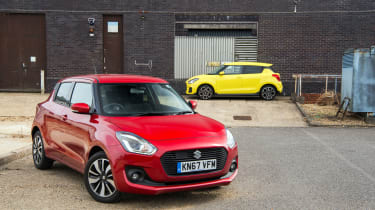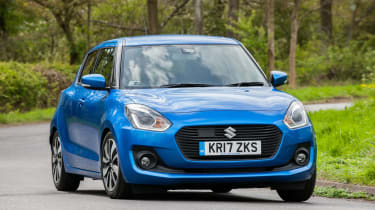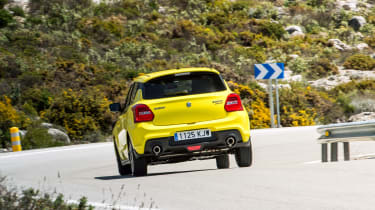Suzuki Swift review – a lively, tech-laden supermini - Ride and handling
The regular Swift and the Swift Sport share many attributes, but the hot hatch fails to live up to expectations
Ride and handling
The non-Sport Swift might not be the sort of car evo usually focuses on, but it’s rare that a small, light and basic hatchback doesn’t offer some sort of entertainment. The regular Swift does nothing to upset that balance and is a natural, consistent and enjoyable car to pedal down a B-road.
Much of the enjoyment when driving the Swift comes from how light it feels; even with the extra motor and battery of the mild-hybrid system, the SZ5 manual Swift weighs under a ton (980kg). Its soft chassis absorbs bumps with ease but doesn’t allow unnerving amounts of lean in corners and the body rarely feels wayward over crests and undulations. It also responds willingly to the throttle inputs, bounding forward whenever you press the accelerator in any meaningful way.
Push it hard, like you might a performance hot hatch, and the pitch during acceleration is enough to create traction issues – but this isn’t a hot hatch so it seems cruel to mark it down just because it doesn’t cope with the most enthusiastic of driving. Especially when it is very competent and enjoyable during slightly less exuberant driving.
It’s that sort of driving where the Swift Sport should shine, what with it being the performance car of the range. Sadly, it too is best driven at seven-tenths. In many respects, the Sport feels like a regular Swift – it’s soft and comfortable, yet it’s light (even lighter in fact at 975kg) and nimble. It feels quick; the engine punches really hard, there’s no turbo lag and it has a deep growl. If you didn’t know it was a 1.4-litre turbocharged motor, you’d guess it was a bigger-capacity (1.6- or 1.8-litre) naturally aspirated engine. The gearchange of the six-speed is tighter, more mechanical and much nicer to use.
More reviews
Group tests
In-depth reviews
Reviews
All very promising, then. But the first sign that all is not perfect is the steering. It’s initially very heavy and weighty around the straight-ahead position, but then gets much lighter as you make bigger steering movements. It’s almost as if the lane keep assist function is acting against you to keep the car straight – even though it’s fully turned off. It’s so odd that it completely dominates the driving experience; you can’t help but focus on the steering even if you’d rather be enjoying the car’s lightweight feel and gutsy engine.
The steering’s quirks are less noticeable on a more tortuous stretch of road with tighter corners where you need to make larger inputs. But in these situations you put more load into the chassis and you quickly realise the Sport, like the regular car, lacks the control and tension needed to drive it with much verve. Cornering is more about keeping roll to a minimum than it is about carrying speed. That wouldn’t matter so much if you could employ all of the punchy engine on the exit of a bend, but the soft suspension allows the rear to dive and unload the front tyres when you accelerate and you leave most second-gear bends with the front inside wheel spinning.
If comfort, gadgets and a surprising shot of straight-line speed are all that’s important to you, the Swift and Swift Sport will certainly fit your criteria. If a lively, engaging and adjustable chassis – the sort of thing that we think is essential on a hot hatch – is what you’re looking for then neither will satisfy. And that’s OK for an ordinary supermini, but not for a hot hatch, not for the Swift Sport.





